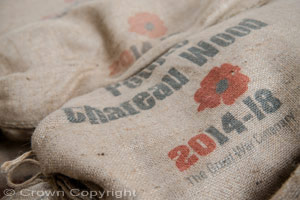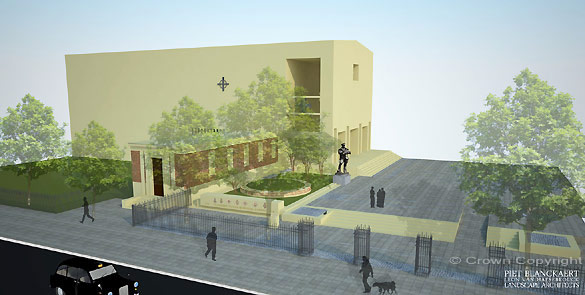|
SACRED SOIL FROM FLANDERS FIELDS
& THE MEMORIAL GARDEN
|
 Sandbags, similar to those used during the First World War
Sandbags, similar to those used during the First World War |
During the summer of 2013, over 1,000 British and Belgian schoolchildren collected 70 sandbags of soil from the battlefields of Flanders, where 4,096 soldiers of the Guards regiments died in The Great War. On Armistice Day, 11th November, at the Menin Gate, some of those children helped to load the bags on to a gun carriage of the King’s Troop Royal Horse Artillery, to begin the journey back to London. The Duke of Edinburgh, Colonel Grenadier Guards, along with Prince Laurent of Belgium, the Major General, and senior representatives of each Household Division regiment, were present. As the 70 bags were placed neatly and gently on the gun carriage, the Band of the Coldstream Guards played Elgar’s Nimrod and Henry Purcell’s When I am laid in Earth Remember Me from Dido and Aeneas.
 The Belgian Naval Frigate Louise Marie
The Belgian Naval Frigate Louise Marie
approaches HMS Belfast |
On 29th November, this sacred soil arrived in London, having made the journey by sea on the Belgian Naval Frigate Louise Marie. Moving up the Thames and through Tower Bridge, the frigate moored alongside HMS Belfast, where the bags of sacred soil remained overnight prior to their journey to Wellington Barracks. The following morning, they were placed onto the same gun carriage, and escorted by four mounted troopers of the Household Cavalry, in a procession led by the Brigade Major, Lt Col Simon Soskin, with Maj Dai Bevan as Adjutant. A journey of four miles via the City, West End and then Whitehall, was timed to take the procession through Horse Guards arch during the mounting of the Queen’s Life Guard. On arrival at Wellington Barracks, the soil was laid into a circular bed in the newly constructed ‘Flanders Fields 1914-2014’ Memorial Garden, a project in which The Guards Museum has been a driving force from the outset. To quote Andrew Wallis, the Museum’s Curator, the soil will now be ‘in sight of the main drill square from where so many guardsmen marched away never to return’.
 Wellington Barracks - the sacred soil is placed on the Memorial Garden
Wellington Barracks - the sacred soil is placed on the Memorial Garden |
The Memorial Garden has been designed by landscape architect Piet Blanckaert from Bruges, Belgium, and is intended to be a quiet place of reflection and contemplation. The first level of soil takes the form of a rectangle that refers to the cemeteries and symbolises death. On top is a circular soil bed, representing eternity as a victory over death. The circular shape also refers to the opening in the roof of the Menin Gate in Ypres, from which, on every 11th November, poppies float down. The central circular bed of the garden will hold the sacred soil and the words of John McCrae’s famous poem In Flanders’ Fields will be inscribed upon it. In this way, the circle becomes a final resting place for the earth, a symbolic return of the soldiers who died on the battlefields. The garden will also have a bench made from Flemish Bluestone and trees indigenous to the battlefields of Flanders.
The £700,000 project is being funded jointly by The Guards Museum, public donations and corporate sponsors. So far the people of Belgium have raised some £420,000, including a significant contribution from the Government of Flanders, however there is still a funding shortfall. All being well, the garden will be opened officially following the Service of Remembrance at the Cenotaph on 9th November 2014.
Further information about the Flanders Memorial Garden and how to donate towards the cost of this splendid project may be found at www.memorial2014.com or at www.flandersfieldappeal.com where details can be found about how to ‘sponsor a battlefield’ or buy artwork in support of the project.
The Editor
 The Memorial Garden - artist’s impression
The Memorial Garden - artist’s impression |
|
|




